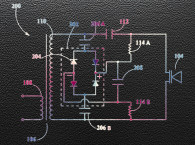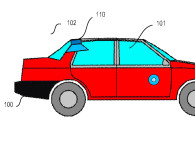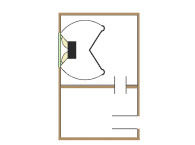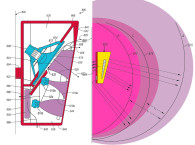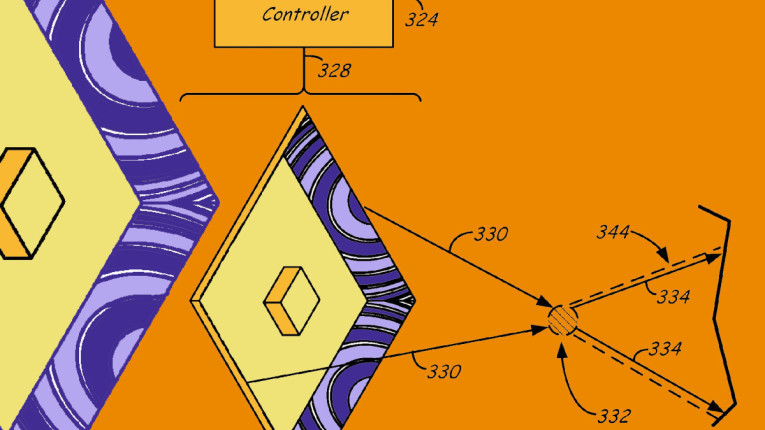
Parametric System for Generating a Sound Halo and Methods of Use Thereof
Patent Number: 9,491,548
Inventors: Luke Batchelder (Somers, NY), J. Samuel Batchelder (Somers, NY)
Assignee: Convey Technology, Inc. (Somers, NY)
Filed: August 24, 2012
Current CPC Class: H04R 5/023 (20130101)
Granted: November 8, 2016
Number of Claims: 18
Number of Drawings: 7
Abstract from Patent
A parametric system for generating audible sound, comprising a transducer array configured to emit modulated ultrasonic waves in a converging wave pattern toward a focal volume, where the modulated ultrasonic waves are configured to demodulate to generate audible sound waves in the focal volume, and where the generated audible sound waves emanate from the focal volume with a diverging wave pattern.
Independent Claims
1. A parametric system for generating audible sound, the parametric system comprising: a transducer array free of paraxial transducers and configured to emit modulated ultrasonic waves in a converging wave pattern toward a focal volume, wherein the modulated ultrasonic waves are configured to demodulate to generate audible sound waves in the focal volume, and wherein the generated audible sound waves emanate from the focal volume with a diverging wave pattern; a controller configured to operate the transducer array to emit the modulated ultrasonic waves; and wherein the transducer array comprises planar sheets of a transducer material with patterned electrodes such that the electrodes comprise a contiguous electrode at a constant distance from the center of the focal volume.
7. A parametric system for generating audible sound, the parametric system comprising: a transducer array that is free of paraxial transducers, wherein the transducer array is configured to emit modulated ultrasonic waves with a numerical aperture ranging from greater than about 0.05 to about 0.5 toward a focal volume, such that the emitted modulated ultrasonic waves generate a sound pressure level in the focal volume of at least about 150 dB; and a controller configured to operate the transducer array to emit the modulated ultrasonic waves, wherein the transducer array comprises a plurality of transducers that are spaced an integer number of wavelengths apart from the center of the focal volume.
12. A method for generating audible sound, the method comprising: emitting modulated ultrasonic waves in a converging wave pattern toward a focal volume with an array of transducers comprising a plurality of transducers spaced around the center of the focal volume and the array being free of paraxial transducers; demodulating the emitted ultrasonic waves to generate audible sound waves in the focal volume; and emanating the generated audible sound waves from the focal volume in a diverging wave pattern.
Reviewer Comments
A parametric loudspeaker is an electro-acoustic transduction method that generates an audio frequency modulation of an ultrasonic wave-train into the air, driving the air to nonlinearity and creating the desired audio frequencies (and unfortunately, many other frequencies) in a highly directional air column projecting out from the ultrasonic transducer.
The parametric loudspeaker is one of those technologies that get rediscovered and “invented” about every 10 years.
The principle was first discovered and characterized for underwater use in the 1963 Journal of Acoustical Society of America (JASA) paper “Parametric Acoustic Array” by Peter J. Westerfelt. In 1965, H. O. Berktay wrote his famous (famous among nonlinear acoustics geeks) Journal and Sound Vibration paper, “Possible exploitation of nonlinear acoustics in underwater transmitting applications,” characterizing the distortion correction scheme to operate a parametric loudspeaker with low distortion. He found that the parametric process “squared” the audio input signal, so the linearizing method was to pre-process the audio signal by taking the square-root of the absolute value of the audio input waveform and using that as the basis for performing the modulation of the ultrasonic carrier frequency. It turns out that this is only valid for very small signal levels.
For many years, Westerfelt and Berktay argued that a parametric array would only operate effectively underwater. It wasn’t until 10 years later that Dr. David T. Blackstock and his assistant Mary Beth Bennett (who did most of the work) proved that a parametric loudspeaker array could operate in an air medium and published their results in the 1975 JASA paper, “Parametric Array in Air.”
Almost a decade later, in 1983, a number of Japanese universities and companies made a next-generation attempt at creating practical airborne parametric loudspeakers, documented with the JASA paper, “The Audio Spotlight: An application of nonlinear interaction of sound waves to a new type of loudspeaker design” by Masahide Yoneyama, et al. Their efforts were followed by many other Japanese audio engineers and researchers developing new techniques to increase the low efficiency of the parametric loudspeaker (using Dynamic Carrier Frequency Amplitude levels) and to reduce the distortion by applying the Berktay square-root pre-processing. A large parametric loudspeaker the size of a billboard was used in the 1984 World’s Fair in Japan to beam sound across the fair grounds to specific listeners.
Ten years later, in 1996, Elwood Norris, at American Technology Corporation (ATC), not knowing about the historical work that had been done in parametric loudspeakers, independently “re-invented” the parametric system under the trademark name of “Hyper Sonic Sound” or HSS. In 1997, I was hired to run the Advanced Development Department at ATC with the purpose of developing a commercially viable parametric loudspeaker. From 1998 to 2008, we developed new piezo-film, PVDF ultrasonic transducers, a new type of Class-D modulation amplifier, and a dynamic signal form of preprocessor that applied the Berktay square-root function at small signals and included a proprietary level dependent transitional preprocessing that maintained low-distortion at all signal levels, with multiple US patents on each technology area, including; US Patent 7,376,236, US Patent 7,224,219, and US Patent 8,275,137.
Now, about a decade later (See what I mean about every 10 years?) a number of companies are attempting to develop new parametric loudspeaker systems, including Microsoft and the inventor of the current patent under review. Disclosed is a parametric system for generating audible sound including a transducer array configured in a curved orientation to emit modulated ultrasonic waves in a converging wave pattern toward a focal point in space, where the modulated ultrasonic waves are configured to demodulate to generate audible sound waves at the focused point, and where the generated audible sound waves emanate on past the focused point with a diverging wave pattern. The invented system also includes a controller configured to operate the transducer array to emit the modulated ultrasonic waves.
The parametric system includes a transducer array that is free of transducers that are centered in the array, such that there are no transducers in line with the center axis of the projected sound beam. The focused array is said to achieve an ultrasonic output of at least 150 dB at the focal point in front of the transducer array.
The operational method of the system includes emitting modulated ultrasonic waves in the converging wave pattern toward the focused point in space, demodulating the emitted ultrasonic waves to generate audible sound waves at the focal point, and emanating the generated audible sound waves from the focal point, onward, in a diverging wave pattern.

With a standard, non-focalized parametric loudspeaker, the audible sound column is very directional (approximately ±6° over the bandwidth of the system), and the sound pressure level (SPL) can be substantially maintained throughout the length of the ultrasonic column. In certain applications, the sound meant for a single targeted listener (and to be isolated from other nearby listeners off to the side from the primary listener) will continue on at full volume and reflect off of the first reflective surface and disperse and bounce to the other “unintended” listeners. Parametric loudspeakers also have low efficiency and a limited maximum output level and low frequency limit (usually about 90 dB of audible output capability down to approximately 350 Hz).
The invention uses the curvature and orientation of the transducer array to focus to a point in space that is a predetermined distance from the array structure, such that the output at that focal point is significantly increased due to applying the full output to a very small volume of space, and since the dispersion increases significantly beyond the focal point, the output also falls off quickly with increased distance from the array.
The goal is to increase ultrasonic and audio output at the focal point, but to have comparatively low output before and after the focal point so as to only be audible for a single listener positioned at the focal point and substantially silent for any listeners positioned away from the focal point. This approach can work to achieve a significant increase in output and also to create a more isolated listening result, but there are several issues that were not explored in the patent disclosure.
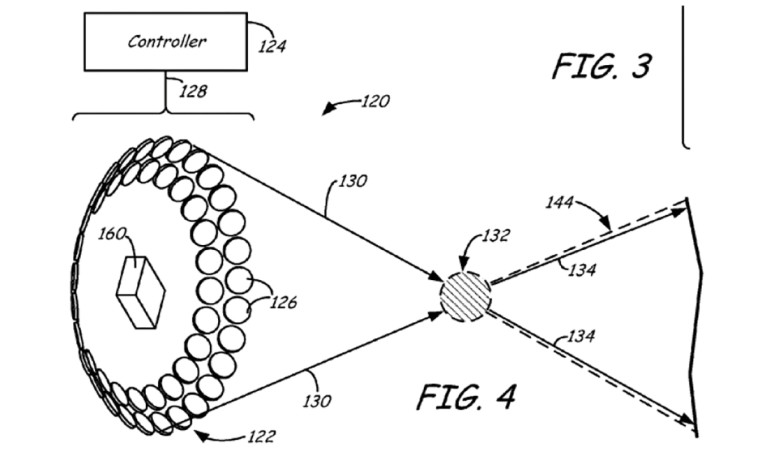
Since the conversion efficiency of a parametric system is such that 140 dB of ultrasonic tends to produce about 90 dB of audio, and levels above 140 dB compress such that further increases of ultrasonic output delivers a lesser increase in audio as the levels increase. When the ultrasonic-beam is focused, with the goal of reaching over 150 dB at the focal point, there are a number of questionable, unintended, side effects, such as:
- The output starts to saturate the air, creating a compressed effect of the ultrasonic and audio output
- Significant local heating effects start to appear, such that it can cause burning where heat can build up between one’s fingers and can actually be deadly for small fur covered animals, such as a mouse that will die if exposed to a steady 155 dB.
- A significant portion of the population can get ultrasonic sickness from levels above 130 dB. (It seems to affect the inner ear, causing headaches, and also nausea with people that are sensitive to motion sickness)
- Last, the focal point is so small where the increase in audio is significant, one cannot get their head and both ears positioned to be within the beam. If one moves out to where the output spread is large enough to encompass at least a head-width, the audio output is significantly reduced.
This focalized approach to parametric loudspeakers has been attempted by others: First by NEC Corp. of Japan in US patent 6,556,687, “Super-directional loudspeaker using ultrasonic wave,” invented by Koji Nanabe and by American Technology Corp. (ATC) in US patent 2005/0195985, “Focused Parametric Array,” and “Parametric Loudspeaker with Improved Phase Characteristics,” invented by James J. Croft III, et al.
With the “Focused Parametric Array” patent from ATC, the small focal point size was advantageously used by having two arrays, focusing one on each ear of a listener, which allows reduced ultrasonic output requirements minimizing the above listed problems and provides natural, left/right isolated binaural spatialization that normally requires spatialization processing.
The patent under review does not address the many aspects that have to be optimized to the point of realizing a practical and useful device. To achieve useful conversion efficiency, low distortion, and high fidelity, the signal processing requirements are quite sophisticated and the focalized approach, while increasing output and efficiency in the focalized space, contain four problems that can be rather intractable, but are obviously critical to solve to realize a practical system. With further development, the system could be made into a practical device, but I suspect we might need to wait for the next parametric systems that will be re-invented in another 10 years or so. VC
This article was originally published in Voice Coil, February 2017.



